Carb counting may seem very confusing but it is actually very easy, using two simple methods.

Two Ways To Count Carbs
There are basically 2 ways to count carbs and they are both much easier than you think.
The 2 methods are ‘grams of carbs‘ or ‘carb choices‘ – they are essentially the same thing but counting grams of carbs is more accurate than carb choices.
I’ll just say that again because if you want to gain good control over your blood sugar levels, then counting grams of carbs is much better.
Watch or read to learn how to get the best results out of your diabetic diet by carb counting.
Carb Counting Video
Let’s look at both methods of carb counting, starting with carb choices first.
Carb Choices
You might find that carb choices are recommended to you by your dietitian or doctor. Here at Diabetes Meal Plans we don’t use carb choices, but it’s good to know about it all the same.
1 Carb Choice = 15 grams carbohydrate
What one carb choice really means is one serve of carbohydrate food because one serve has approximately 15 grams of carbohydrate.
Here are some examples of 1 carb choice:
- 1 slice bread
- 1/2 cup rice
- 1 small piece fruit
- 1/2 cup beans or lentils
- 1/2 cup corn
- 1/2 cup mashed potato or sweet potato
- 1/4 – 1/2 cup cereal
- 1/2 cup cooked cereal
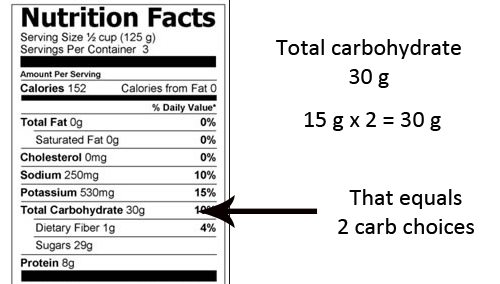
Here is an example of how to use the carb choices counting method.
You will have to get familiar with reading food labels and one of the main things to check is the carb count. There are other things to look for too but we’ll leave those to another time.
It’s important to emphasize the reading of food labels because in order to monitor carb intake and control blood sugar, you really have to read labels and know what you’re actually eating. What you want to look for is the total carbohydrate per serving.
As you can see in the example above there is a total of 30 g of carbohydrate, so if one carb choice is 15 g and we multiply that by 2 we get 30 g, that means you have 2 carb choices in one serve of that food item.
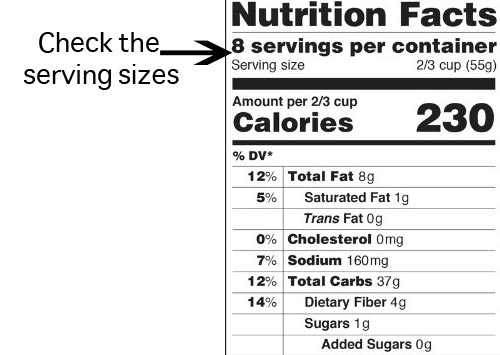
Another important thing to take note of is the serving size listed at the top.
Manufacturers often use small serving sizes – meaning they trick us into eating more food. Our idea of serving sizes is often very different to the portions recommended on the package, so take note of how much is in one serve so you don’t end up eating double the amount of carbs.
It is very easy to consume more than one serving if you are just trying to guess!
Counting Grams of Carbs
It’s still important that you take note of the serving size because you don’t want to overeat!
With the gram counting method you want to take note of 2 things, the total carbohydrate and the fiber content because we are going to calculate net carbs.
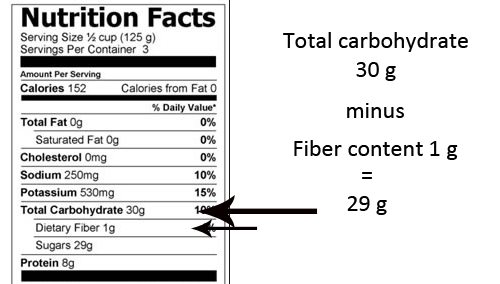
To calculate net carbs we take the total carbohydrate and minus the fiber content. So in this example the fiber content is only 1 g, which makes the net carb count 29 g.
Fiber does not contribute to blood sugar or cause insulin spikes and is considered ‘free’ food, so it does not count toward total daily carbohydrate intake when you are counting in grams.
Dietitian Aglaee Jacob points out that when a food has a small amount of available carbohydrates this is not problematic for diabetes control.
What she means by available carbohydrates is that fiber does not affect blood sugar levels, only starch and sugar does. So when you subtract the amount of fiber in a food you are left with the net carbs, which is the net effect of that carbohydrate food.
Sometimes it seems like a food has quite a bit of carbohydrate but once you minus the fiber you’re left with very low ‘available carbohydrate content’.
Let’s look at another example of counting net carbs.
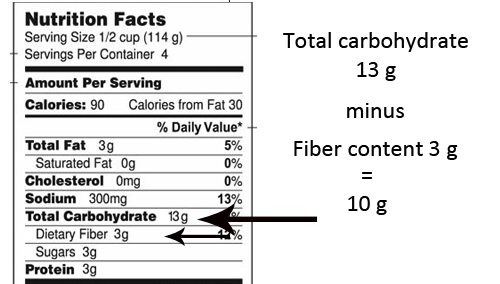
In this example we have 13 g total carbohydrate and 3 g fiber, so if we minus the fiber from the total carbs we are left with 10 g net carbs.
The best thing to do if you want to gain better blood sugar control is to keep a food log of all the things you eat and drink over the day. Then add up your net carbs for the day to get your daily carb amount or your per meal carb amount. This helps you to adjust your meal plan to lower blood sugar and A1C or manage them better.
VERY IMPORTANT

Here at Diabetes Meal Plans we recommend eating a whole foods anti-inflammatory diet that is lower in carbohydrates.
One key point to mention is that following this style of diet means that most of the foods you eat WILL NOT COME IN A PACKET!
This means the majority of the foods you eat will not have a food label. Broccoli, carrots and kale don’t need a food label. Nor do fresh meats.
The idea is to move away from processed and packaged foods. Just to emphasize this point again – things like meats, eggs, and vegetables don’t need food labels, right?!
That’s the key point. 🙂
EAT MORE VEGETABLES
It’s very important to choose LOTS of vegetables because vegetables are the best source of carbohydrates.
Especially choose from non-starchy vegetables such as broccoli, asparagus, cabbage, cauliflower, tomato, lettuce, cucumber, bell pepper, zucchini, and other vegetables that grow above the ground.
This means you can fill up on them, get valuable nutrients, and be improving your health at the same time.
There is a low amount of net carbs in vegetables so when you choose mostly vegetables, you still get adequate carbs in your diet but you won’t have to think so much about rigorous carb counting.
Overall that just makes eating every day A LOT easier.
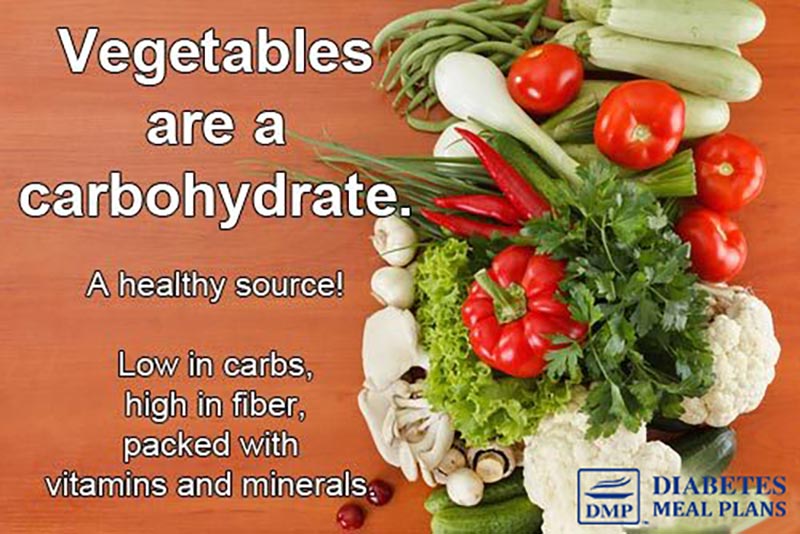
Log Your Food
Carb counting and monitoring the food you eat is very important. If you just guess or don’t monitor anything, chances are you’re probably going to end up overeating, and eating foods you really shouldn’t be eating.
Of course, if you stick to eating fresh, natural foods like the ones we are going to teach you to eat here, then carb counting becomes much easier, less important almost.
Eating 1200 calories of junk doesn’t mean you will lose weight, because the chemical component of foods has an influence on the bodies natural biochemistry – that’s why low calorie diets often still leave people struggling with weight loss.
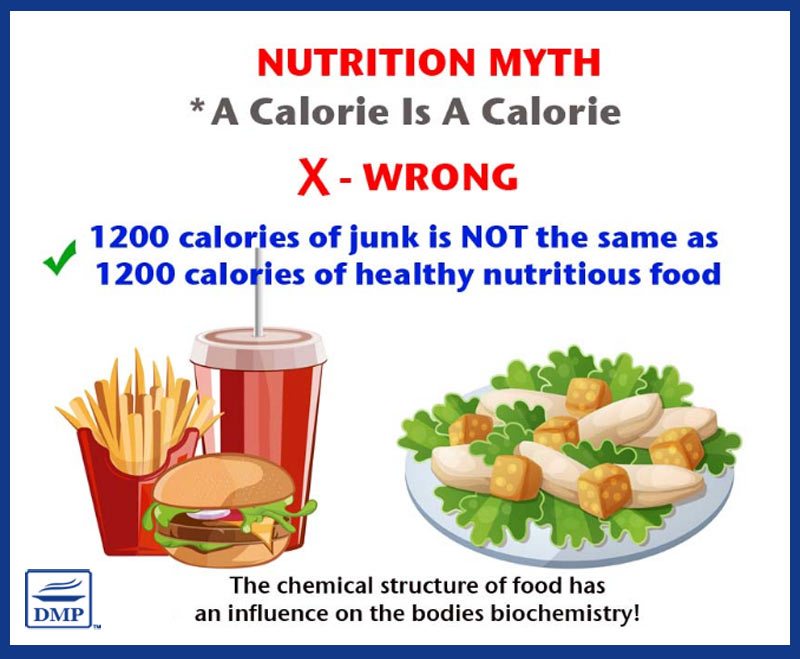
Focus on food quality and lots of other things will begin to fall into place.
Recap: There are 2 carb counting methods, (1) Carb Choices, (2) Grams of Carbs.
Grams of carbs is more accurate than carb choices.
Please share, pin, or tweet this info to help others. Thanks!.


Raani
Hi Jedha, I have followed you over here; still trying to wrap my head around the carb counting or grams of counting. I don’t get where the fiber comes from. I will keep reading and until by some magic I will see where the fiber comes from
Jedha: Nutritionist (MNutr)
Fiber is contained in many foods Raani. In terms of nutrition facts, it is assessed separately in number form. For example, 86g broccoli = 6.2 g carbs, 2.8 g fiber.
Raani
Thanks for the great explanation on carb counts. I will print this and have the local stationery guy laminate this whole explanation.
I really appreciate how you focus on what is really important and not having explanations from many sources.
If I bring home from the market broccoli, cauliflower, green beans, spinach, mustard leaves, etc does that mean that I do not have to worry about grams of carb. If I buy curd or milk or toful or paneer ; then I do count those items. Am I beginning to understand this.
question: on the ‘blood sugar tracker’ it seems it starts with Sunday and ends with Sunday. Is there a reason for that?
Raani
Jedha: Nutritionist (MNutr)
Many organizations would say don’t count vegetables, but vegetables are a carbohydrate so they should be calculated in your total daily number. So you’d estimate the amount of carbs in the milk, tofu, paneer and all the veggies you had. They will be low overall, but still important. 🙂 The other, admittedly, human error. We will have the tracker updated. 🙂
Lynn
Thank you so much! I have recently been diagnosed with diabetes and have been so very confused. This helped me so so much!!
Carmen
Thanks for your valuable information! In my case being type 2 I only have to quit grains and portion beans and other legume and the results are inmediate my levels go back to 5.3.
Jedha
Good to hear your controlling your levels well Carmen – everyone’s body is different but cutting out those grains is a big factor!
Chrystal Abhalter
Your information is invaluable. Thanks for tips on vinegar/lemon tea, fruit carbs, Japanese low-carb noodles, and honey. I am surprised that many people don’t realize that honey is sugar. I was eating “an apple a day” until I realized that a spike soon followed. I look forward to your daily emails since I can focus on one section at a time,
Jan
You have been more help to me in the time I’ve signed on with you than the five years since I was diagnosed by my Dr. Can’t thank you enough for helping me get my diabetes under control.
Jedha
That’s fantastic to hear Jan, so glad to have you with us! Look forward to hearing about your progress.
Susan
In the 1st counting grams illustration the Sugar is 29 grams. Isn’t that high?
Jedha
In most cases Susan, you will ignore the sugar level because it does not give an indication of “added sugar” or natural sugar contained in a food, so it’s irrelevant. All you need to consider is the total carb count and fiber.
Eifa
Hi,
Your video is a good one dear, but you should focus on all food groups and not only Vegetables.
Please do discuss about other food groups as well in Carbohydrate counting.
Thanks.
Jedha
Hi Eifa, we encourage a low carb diet here at Diabetes Meal Plans so there is always a big emphasis on vegetables as other food groups of carbs – potatoes, bread, rice, pasta – are not really recommended. You can read some of our top dietary resources over here.
carrie
So far what i have learned about carbs has really helped me understand what i need to know about carbs. I can’t wait for more
Jedha
Thanks for the feedback Carrie, glad you’re finding it helpful :)
sharon hise
Was wondering if you go by net carbs or not. Sometimes there is a big differnce once you subtract the fiber. My husband was diagnosed last month and has lost almost twenty pounds so I guess what I’m doing works. Have enjoyed reading all this info…thanks
Jedha
Generally yes. Calculate net carbs. Still, if what you’re doing is working, just keep doing that. You can tweak later if he hits a plateau or needs better results :)
Jody
Hello Jedha
So far I love what I have read, I am going to be signing up in the next week or so, and I was wondering though I like cottage cheese once in a while will this be ok to eat. I can not stand the lo or no fat variety though I eat the 2% or full fat will I have to quit eating it.
Jedha
Cottage cheese is a safe food Jody. It’s low in carbs and higher in protein with a full range of amino acids.
Leanne
is there a maximum amount of carbs we should be eating per day?
when i read the grams of carbs on the label is there a number i shouldn’t go above?
Jedha
Hi Leanne, if you’re taking the Carb Course you will get that info. Here it is https://diabetesmealplans.com/6578/
If not, you can sign up here and take the complete course. It will end all your confusions :)
Pam Cullinan
I cant wait yo get started
Jedha
Fantastic Pam!! People have been giving us great feedback so we hope you enjoy it as much as they do. :)
Beverly
Hi Jedha, wonderful info. Makes me want to eat correctly when I understand carbs. In one of your lessons you mentioned having 2TLBS of cider vinegar with cheese before bedtime. My question , is vinigar harmful to enamel of your teeth?
Jedha
Hi Beverly, Glad you’re enjoying it and finding motivation!
I’ve taken a lemon/ apple cider vinegar drink every morning for years and have excellent teeth. But I did have a dental nurse once say I shouldn’t do it because of the reason you pointed out. She suggested using a straw. If you’re worried, do that and you’ll have no concerns. :)
Read some more about this type of drink here https://diabetesmealplans.com/5656/diabetic-weight-loss-wellness-drink/
Fred
Hi, I am finding the info on carbs very helpful planing my meals. You have made the whole carbs world easier to understand……..Thanks…..Fred
Jedha
That’s great Fred. So glad it’s helping make things clearer. :)